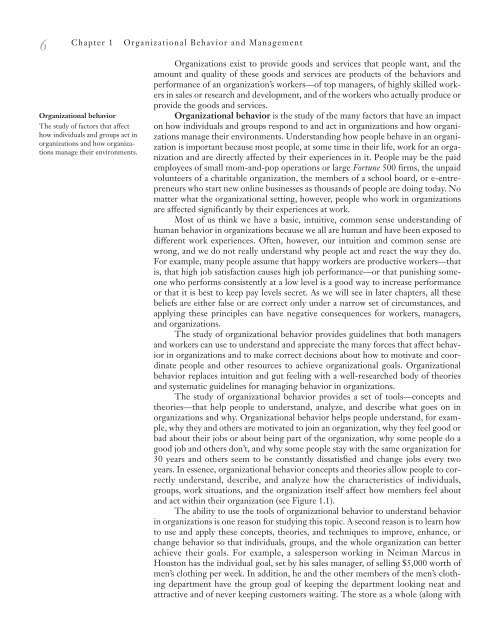chapter - Pearson
chapter - Pearson
chapter - Pearson
You also want an ePaper? Increase the reach of your titles
YUMPU automatically turns print PDFs into web optimized ePapers that Google loves.
6<br />
Chapter 1 Organizational Behavior and Management<br />
Organizational behavior<br />
The study of factors that affect<br />
how individuals and groups act in<br />
organizations and how organizations<br />
manage their environments.<br />
Organizations exist to provide goods and services that people want, and the<br />
amount and quality of these goods and services are products of the behaviors and<br />
performance of an organization’s workers—of top managers, of highly skilled workers<br />
in sales or research and development, and of the workers who actually produce or<br />
provide the goods and services.<br />
Organizational behavior is the study of the many factors that have an impact<br />
on how individuals and groups respond to and act in organizations and how organizations<br />
manage their environments. Understanding how people behave in an organization<br />
is important because most people, at some time in their life, work for an organization<br />
and are directly affected by their experiences in it. People may be the paid<br />
employees of small mom-and-pop operations or large Fortune 500 firms, the unpaid<br />
volunteers of a charitable organization, the members of a school board, or e-entrepreneurs<br />
who start new online businesses as thousands of people are doing today. No<br />
matter what the organizational setting, however, people who work in organizations<br />
are affected significantly by their experiences at work.<br />
Most of us think we have a basic, intuitive, common sense understanding of<br />
human behavior in organizations because we all are human and have been exposed to<br />
different work experiences. Often, however, our intuition and common sense are<br />
wrong, and we do not really understand why people act and react the way they do.<br />
For example, many people assume that happy workers are productive workers—that<br />
is, that high job satisfaction causes high job performance—or that punishing someone<br />
who performs consistently at a low level is a good way to increase performance<br />
or that it is best to keep pay levels secret. As we will see in later <strong>chapter</strong>s, all these<br />
beliefs are either false or are correct only under a narrow set of circumstances, and<br />
applying these principles can have negative consequences for workers, managers,<br />
and organizations.<br />
The study of organizational behavior provides guidelines that both managers<br />
and workers can use to understand and appreciate the many forces that affect behavior<br />
in organizations and to make correct decisions about how to motivate and coordinate<br />
people and other resources to achieve organizational goals. Organizational<br />
behavior replaces intuition and gut feeling with a well-researched body of theories<br />
and systematic guidelines for managing behavior in organizations.<br />
The study of organizational behavior provides a set of tools—concepts and<br />
theories—that help people to understand, analyze, and describe what goes on in<br />
organizations and why. Organizational behavior helps people understand, for example,<br />
why they and others are motivated to join an organization, why they feel good or<br />
bad about their jobs or about being part of the organization, why some people do a<br />
good job and others don’t, and why some people stay with the same organization for<br />
30 years and others seem to be constantly dissatisfied and change jobs every two<br />
years. In essence, organizational behavior concepts and theories allow people to correctly<br />
understand, describe, and analyze how the characteristics of individuals,<br />
groups, work situations, and the organization itself affect how members feel about<br />
and act within their organization (see Figure 1.1).<br />
The ability to use the tools of organizational behavior to understand behavior<br />
in organizations is one reason for studying this topic. A second reason is to learn how<br />
to use and apply these concepts, theories, and techniques to improve, enhance, or<br />
change behavior so that individuals, groups, and the whole organization can better<br />
achieve their goals. For example, a salesperson working in Neiman Marcus in<br />
Houston has the individual goal, set by his sales manager, of selling $5,000 worth of<br />
men’s clothing per week. In addition, he and the other members of the men’s clothing<br />
department have the group goal of keeping the department looking neat and<br />
attractive and of never keeping customers waiting. The store as a whole (along with

















